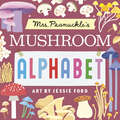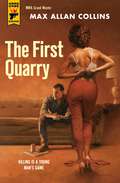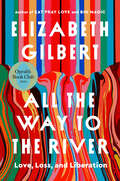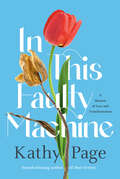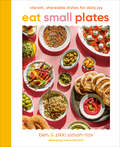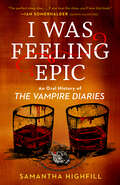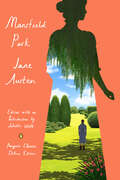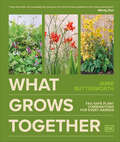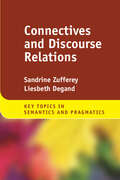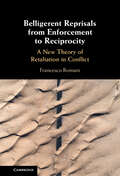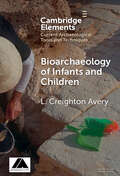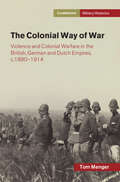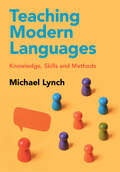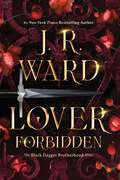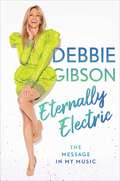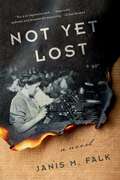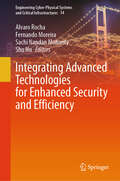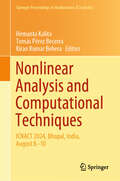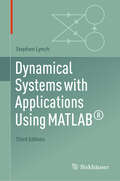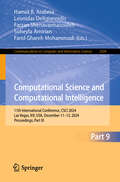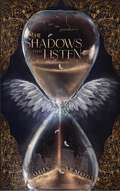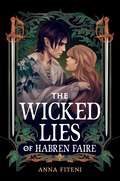- Table View
- List View
Mrs. Peanuckle's Mushroom Alphabet (Mrs. Peanuckle's Alphabet)
by Mrs. PeanuckleThere's so much more to mushrooms than morels and portobellas: a whole alphabet more. Teach your little one about the incredible ABCs of your favorite fungus!Calling all mushroom enthusiasts who forage, sautee, and savor every earthy bite. Step into the magical world of 'shrooms as Mrs. Peanuckle guides readers through the alphabet with these mystical and amazing fungi. Little ones will learn about fun species like lion's mane, enoki, and hen of the woods!This book is perfect for new parents and families eager to share their love of nature and food with little ones while teaching them their ABCs.Collect all of Mrs. Peanuckle's Alphabet books including:Mrs. Peanuckle's Fruit AlphabetMrs. Peanuckle's Vegetable AlphabetMrs. Peanuckle's Bug AlphabetMrs. Peanuckle's Hiking Alphabet
The First Quarry (Quarry)
by Max Allan CollinsBIG MAN ON CAMPUS Crime fiction readers know Quarry, the ruthless killer-for-hire, from Max Allan Collins&’ acclaimed novels – most recently THE LAST QUARRY, which told the story of the assassin&’s final assignment (and was the basis for the feature film The Last Lullaby). But where did Quarry's story start? For first time ever, the best-selling author of ROAD TO PERDITION takes us back to the beginning, revealing the never-before-told story of Quarry&’s first job: infiltrating a college campus and eliminating a professor whose affair with one of his beautiful, young students is the least of his sins…
All the Way to the River: Love, Loss, and Liberation
by Elizabeth Gilbert"A delicious mashup of narrative that's by turns harrowing and healing." –People&“Entertaining, insightful, wrenching … punch-to-the-gut powerful.&” –The Washington Post&“A blockbuster: brutally honest, lurid, transcendent, and compelling…Gilbert is undoubtedly a force.&” —Boston Globe In her first nonfiction book in a decade, the #1 bestselling writer who taught millions of readers to live authentically (Eat Pray Love) and creatively (Big Magic) shows how to break free.In 2000, Elizabeth Gilbert met Rayya. They became friends, then best friends, then inseparable. When tragedy entered their lives, the truth was finally laid bare: The two were in love. They were also a pair of addicts, on a collision course toward catastrophe.What if your most beautiful love story turned into your biggest nightmare? What if the dear friend who taught you so much about your self-destructive tendencies became the unstable partner with whom you disastrously reenacted every one of them? And what if your most devastating heartbreak opened a pathway to your greatest awakening?All the Way to the River is a landmark memoir that will resonate with anyone who has ever been captive to love—or to any other passion, substance, or craving—and who yearns, at long last, for liberation.
In This Faulty Machine: A Memoir of Loss and Transformation
by Kathy PageAn exquisite memoir of the author&’s life since being diagnosed with Parkinson&’s disease—informative, funny, and moving all at once.Acclaimed novelist Kathy Page had just completed a promotional tour for her award-winning book Dear Evelyn when a fall during a hike injured her hand. That relatively minor accident seemed to set in motion a cascade of other seemingly unrelated physical issues. Many months of appointments, and of waiting for appointments (including during the COVID lockdown) ensued, until the day that pulled everything together in a single, frightening diagnosis: Parkinson's disease.In This Faulty Machine is an eye-opening, often lyrical and very funny report from that "other kingdom" of illness, from an observant, wise, and honest involuntary resident. The author's acute yet welcoming voice draws us into the erratic, intimate, and troubling effects of the disease and its impact on her relationships alongside the pleasures of family, friends, reading, writing, and the natural world. This one-of-a-kind memoir offers a thoughtful exploration of the complex and evolving science of this debilitating disease, a gripping account of the various ways that it impacts both PWP (People with Parkinson's) and their families. The book is also a unique look into the creative process of a life-long novelist who finds that she can no longer create in the way she has for decades.Wise and warm, the book makes an important contribution to the understanding of Parkinson's disease but is also a rich and heartfelt memoir of creativity and a life being well-lived, even as the challenges mount. It is a story of vital interest to us all as we face our own fragility, and indeed, mortality.
Middle Spoon: A Novel
by Alejandro Varela&“Middle Spoon subverts the ordinary novel with intelligence and vulnerability. . . . Varela has made a sly, analytical opera of the heart.&” —Andrew Sean Greer, author of Less and Less Is Lost &“A rollicking delight! . . . Varela asks provocative questions about the shape of family and the nature of love.&” —Ada Calhoun, New York Times bestselling author of Crush One of TODAY&’s 50 Books We Can&’t Wait to Read in 2025 · Named a Must-Read Book of Fall 2025 by Town & Country, Lit Hub, and W Magazine A whipsmart, blazingly funny novel about heartbreak, unconventional love, and the way society could be, from National Book Award finalist Alejandro VarelaThe narrator of Middle Spoon appears to be living the dream: He has a doting husband, two precocious children, all the comforts of a quiet bourgeois life—and a sexy younger boyfriend to accompany him to farmers markets and cocktail parties. But when his boyfriend abruptly dumps him, he spirals into heartbreak for the first time and must confront a world still struggling to understand polyamorous relationships. Faced with the judgment of friends and the sting of rejection, he&’s left to wonder if sharing a life with both his family and his lover could ever truly be possible.With a big heart and just the right dose of the anxieties that define the modern era, Middle Spoon skewers the unspoken rules we still live by—from taboos around intimacy to the shortcomings of Oscar season, pop culture, and gluten-free food—offering a surprising perspective on love, loss, and reinvention. Equal parts heart-wrenching and uproariously funny, Middle Spoon is for anyone who has longed, nursed a broken heart, or grappled with love at its messiest.
Eat Small Plates: Vibrant, Shareable Dishes for Daily Joy
by Ben Siman-Tov Zikki Siman-TovThe dynamic couple behind @BenGingi share their favorite mix-and-match-ready recipes for effortless everyday dining and easy hostingFrom a serendipitous meeting on a street corner in a tiny town in the Italian Alps to their food studio at the heart of the East Village in New York City, Ben and Zikki have been on a culinary adventure since the very moment they met. Ben&’s first gift to Zikki? A half loaf of beetroot sourdough. And their first date? Zikki taught Ben to make potato varenyky, secretly prepping him to help her make 1,000 for an event the following week!These days, with not a moment to spare, they happily host friends and family and run a sought-after catering business in New York City. Their debut cookbook, Eat Small Plates, is an ode to a style of eating at the heart of their lived experiences together: traveling, creating a family, and building beautiful lasting friendships wherever a meal can be shared. Here, they offer their favorite small plate recipes for greater joy and connection every day.Ben&’s knack for vibrant Israeli flavors and Zikki&’s passion for shareable, soul-warming Ukrainian-inspired dishes combine in Eat Small Plates to create bold and exciting recipes for every dinner or gathering. With favorites such as Ben&’s freshly baked Pita, Zikki&’s crunchy chopped Jeweled Celery Salad, and creamy Cashew Basil dip, this ultimate hosting cheat sheet helps home cooks transform simple ingredients into beautiful, intentional dishes. Ben and Zikki share essential cooking techniques—from charring an eggplant to incorporating pickling into your daily routine—and even tips for those who don&’t want to cook at all (but still want to host!). This book is a celebration of the feast-ready lifestyle, and a guide to spreading love through food.
I Was Feeling Epic: An Oral History of The Vampire Diaries
by Samantha HighfillFrom Entertainment Weekly writer and debut author Samantha Highfill, a definitive and deliciously nostalgic look into the creation and legacy of the hit show The Vampire Diaries, as told by its cast, crew, and creators.In 2009, the CW released a show about grief, love, redemption, and, oh yeah, vampires. A graveyard meet-cute, a bit of fog, and one &“Hello, brother&” later, a cultural phenomenon was born, one that would last for 171 episodes across eight seasons and deliver two spin-off series.I Was Feeling Epic takes us back to Mystic Falls for every first kiss, decade dance, and unforgettable death. With brand-new interviews from cast and creatives like Nina Dobrev, Paul Wesley, Ian Somerhalder, Kat Graham, Candice King, Joseph Morgan, Michael Trevino, Zach Roerig, Michael Malarkey, Julie Plec, Kevin Williamson, and so many more, I Was Feeling Epic relives the show&’s best moments, unearths never-before-told stories, and delves into some of the most widely discussed topics surrounding the series and its legacy, all in the words of the people who know it best.Transportive, nostalgic, and perfect for old fans and new, I Was Feeling Epic is the in-depth story behind the vampirically immortal hit: The Vampire Diaries.
Mansfield Park: (Penguin Classics Deluxe Edition) (Penguin Classics Deluxe Edition)
by Jane AustenShy and penniless Fanny Price is brought up on her uncle Sir Thomas Bertram&’s estate, Mansfield Park, as an act of charity. Sir Thomas also owns land— and benefits from the labor of enslaved people— in the Caribbean colony of Antigua. Fanny is miserable until her kind cousin Edmund Bertram takes her under his wing. Having secretly fallen in love with him, Fanny suffers severely when his head is turned by the captivating Mary Crawford. Fanny&’s quiet fortitude makes Mansfield Park one of Austen&’s most psychologically astute novels.
What Grows Together: Fail-safe Plant Combinations for Every Garden
by Jamie Butterworth“I love this book – it’s invaluable for everyone from the first-time gardener to the most experienced.” – Monty Don"This book is a dream for someone like me who knows what they like but can’t always work out how to realize their vision!" – Jo WhileyDo you want stunning pots and borders? These quick and easy planting recipes are all you need!Are you dreaming of a garden full of beautiful planting? Do you need simple, easy advice on which plants to grow together and the conditions they need to thrive?What Grows Together is the ultimate shortcut for achieving a flourishing, well-planted garden. No matter if your garden is big or small, shady or sunny, or if you’ve never planted anything before, with these easy-to-follow planting recipes you will create a vibrant garden in no time.There are over 60 combinations looking their best across spring, summer, and autumn, plus advice on creating extended color and interest into winter. What’s more, all recipes are suitable for containers or borders so there is a winning plant combination for every garden and time of year.
Connectives and Discourse Relations (Key Topics in Semantics and Pragmatics)
by Sandrine Zufferey Liesbeth DegandIllustrated with examples from a rich range of languages and genres, this book provides a state-of-the-art introduction to the meanings and functions of connectives, and the discourse relations they communicate. It begins with theoretical chapters that illustrate the many interfaces present in the study of connectives and discourse relations, using diachronic data to illustrate how connectives incorporate such a wide range of functions in synchronic language use. The second half of the book presents the rapidly growing body of studies that have used empirical data to assess theories of connectives and discourse relations, spanning fields as diverse as discourse processing, first and second language acquisition, and cross-linguistic studies. End-of-chapter discussion questions and lists of further readings are included, along with a comprehensive glossary of key terms. This title is part of the Flip it Open Programme and may also be available open access. Check our website Cambridge Core for details.
Belligerent Reprisals from Enforcement to Reciprocity: A New Theory of Retaliation in Conflict
by Francesco RomaniThis book challenges the traditional understanding of belligerent reprisals as a mechanism aimed at enforcing the laws of armed conflict. By re-instating reciprocity at the core of belligerent reprisals, it construes them as tools designed to re-calibrate the legal relationship between parties to armed conflict and pursue the belligerents' equality of rights and obligations in both a formal and a substantive sense. It combines an inquiry into the conceptual issues surrounding the notion of belligerent reprisals, with an analysis of State and international practice on their purpose and function. Encompassing international and non-international armed conflicts, it provides a first comprehensive account of the role of reprisals in governing legal interaction during wartime, and offers new grounds to address questions on their applicability, lawfulness, regulation, and desirability. This title is part of the Flip it Open Programme and may also be available Open Access. Check our website Cambridge Core for details.
Bioarchaeology of Infants and Children (Elements in Current Archaeological Tools and Techniques)
by L. Creighton AveryThe study of infant, child, and adolescent remains (nonadult remains) is a topic of growing interest within the fields of archaeology and bioarchaeology. Many published volumes and articles delve into the experiences of childhood and what these small remains may tell us about life, more broadly, in the past. For those interested in exploring infant and child remains, it is an exciting period as more methods and approaches are constantly being incorporated into the archaeological toolkit. This Element introduces the reader to the topic and to common methodological approaches used to consider nonadult remains from archaeological contexts. With this toolkit in hand, readers will be able to begin their own explorations and analyses of nonadult human remains within archaeological contexts.
The Colonial Way of War: Violence and Colonial Warfare in the British, German and Dutch Empires, c.1890–1914 (Cambridge Military Histories)
by Tom MengerThe violence of colonial wars between 1890 and 1914 is often thought to have been uniquely shaped by the nature of each of the European empires. This book argues instead that these wars' extreme violence was part of a shared 'Colonial Way of War'. Through detailed study of British, German and Dutch colonial wars, Tom Menger reveals the transimperial connectivity of fin-de-siècle colonial violence, including practices of scorched earth and extermination, such as the Herero Genocide (1904-1908). He explores how shared thought and practices arose from exchanges and transfers between actors of different empires, both Europeans and non-Europeans. These transfers can be traced in military manuals and other literature, but most notably in the transimperial mobility of military attachés, regular soldiers, settlers or 'adventurers'. Pioneering in its scope, Menger's work re-thinks the supposed exceptionality of standout cases of colonial violence, and more broadly challenges conceptions we have of imperial connectivity.
Teaching Modern Languages: Knowledge, Skills and Methods
by Michael LynchAn essential resource for trainee teachers and graduate students, this textbook presents strategies and practical advice for preparing and planning lessons in a clear, step-by-step way and demonstrates how to inspire confidence and competence in language learners. Chapters cover many important aspects of initial teacher training including skills development; modes of teaching; unit and lesson planning; assessment; remote learning; digital literacy, and student and teacher wellbeing. Packed with pedagogical value, each chapter includes clear learning objectives, concise chapter summaries, defined key terms, interactive box features, reflective questions and further reading recommendations. Supplementary resources include templates for planning and assessment, feed-forward and feedback forms, extra tasks and activities, and sample answers. By connecting theory and practice, this authoritative guide provides trainee teachers with the necessary tools to develop the knowledge, skills and methods required to become an effective modern languages teacher in a contemporary world.
Lover Forbidden (The Black Dagger Brotherhood series)
by J.R. WardThe aristocracy is making a run for the throne in this latest thrilling, star-crossed paranormal romance entry in J.R. Ward&’s #1 New York Times bestselling Black Dagger Brotherhood series.When Lyric goes out for the night, she&’s not ready for a brush with death—and she&’s really not ready for the male who comes out of nowhere and saves her. Her family, especially her father, Qhuinn, are so relieved she&’s okay, but all she can think about is her mysterious savior. Without telling anybody, she seeks out Devlin, and they are immediately drawn to one another. Her near-death experience has given her a fresh appreciation for life and the desire to live it to its fullest, but she has no idea that he&’s hiding a secret—or that he could be the key to ending the war between the Black Dagger Brotherhood and the lessers forever.
Eternally Electric: The Message in My Music
by Debbie GibsonIn her long-awaited debut, Debbie Gibson reflects on the lessons she learned in her years as a young pop pioneer and on her hard-earned journey to embrace her authentic self, allowing her to lead the healthy, engaged—and electric!—life she does today. Debbie Gibson was just sixteen when she released her multi-platinum debut album Out of the Blue and recorded &“Foolish Beat&” in 1988, making her the youngest person to ever write, produce, and perform a Billboard Hot 100 chart-topper. A child actress who became the original pop princess, Debbie had full creative control over her music and, when that no longer aligned with a transitioning arts scene, she went on to star in Broadway&’s Les Misérables, Beauty and the Beast, and Cabaret, as well as in the London production of Grease. Yet, for all the accolades and achievements, her success came at a high price. Anxiety, depression, financial struggles, illness—Debbie writes candidly about these and other challenges, and how she ultimately redesigned her life to overcome them. This is the story of her not only surviving, but thriving: returning to her musical roots, releasing new albums, going back out on tour, and living the best version of her authentic self to remain…Eternally Electric!
Not Yet Lost: A Novel
by Janis FalkFor fans of Kristin Hannah and Jennifer Chiaverini, a novel about a Polish immigrant woman who fights against worker oppression in Depression-era Detroit despite opposition by many—even her own husband.In this gritty, cinematic story, hardworking Florence and her best friend, Basia, are enraged by the poor treatment, low wages, and unsafe working conditions they endure in the factory where they hand-roll cigars. Florence is as reserved and compliant as Basia is fiery and forthright. During a time when their choices were between bad and worse, this is an underdog story of a woman who must search for her voice in order to lead a labor movement against her husband&’s violent efforts to silence her. Set in turbulent 1937 Detroit, this novel portrays the Eastern European immigrant struggle when difficult economic times, xenophobia, &“Fordism,&” secret societies, and Communist-led labor organizations buffeted the demographic. Will Florence and her husband resolve their conflicts both inside and outside the home? At what cost?
Integrating Advanced Technologies for Enhanced Security and Efficiency (Engineering Cyber-Physical Systems and Critical Infrastructures #14)
by Alvaro Rocha Shu Hu Sachi Nandan Mohanty Fernando MoreiraThis book examines the profound impact of emerging innovations on security and operational effectiveness. This book brings together leading experts in artificial intelligence, blockchain, IoT, and cyber security to tackle key challenges in protecting digital and physical infrastructures. Covering areas such as automated threat detection, secure data exchange, and intelligent system optimization, the book offers practical strategies and case studies. Designed for researchers, professionals, and policymakers, it serves as a comprehensive resource for harnessing advanced technologies to build resilient and efficient security frameworks. Whether mitigating cyber threats, streamlining industrial operations, or improving decision-making, this book provides essential insights for navigating today&’s rapidly evolving technological landscape.
Conversation Analysis and Language Teacher Education: Intervention Studies (Studies in Language Teacher Education #1)
by Hansun Zhang Waring Olcay SertReconceptualizing intervention and change in conversation analytic perspectives, this volume not only illustrates actual, rather than imagined, ways of conducting CA-informed interventions in a variety of teacher-training contexts around the globe but also documents the impact of such interventions on teacher development. &“The contributors to this volume have intentionally moved CA beyond a descriptive methodology to recognizing how CA-influenced decisions and procedures can, and do, result in productive changes in teachers&’ interactional and instructional pedagogies. A gift to the field of Language Teacher Education, this volume offers rich data-driven evidence of the material impact of engagement with CA on the professional development of language teachers.&” (Karen E. Johnson, The Pennsylvania State University, USA) &“The contributors illustrate how CA-based frameworks can help both pre-service and in-service language teachers sharpen their professional vision and enhance their pedagogical skills, making a compelling case for integrating CA into language teacher education while offering concrete guidance for developing teachers' interactional awareness and competence. This groundbreaking volume will be a key reading in both Applied Linguistics and TESOL programmes.&” (Steve Mann, University of Warwick, UK) &“Conversation Analysis (CA) should be an integral part of teacher-training programs. This plea is convincingly made in this new volume. After many years of CA studies of classroom interaction, it was only a matter of time before CA should enter teacher-training programs. The reports from the US, Sweden, Germany, Türkiye and Japan in this volume show that that time is now.&” (Tom Koole, University of Groningen, The Netherlands) Olcay Sert is Professor of Language Education at Mälardalen University (Sweden). He is leading the Mälardalen INteraction & Didactics (MIND) Research Group and is the editor of Classr
Nonlinear Analysis and Computational Techniques: ICNACT 2024, Bhopal, India, August 8–10 (Springer Proceedings in Mathematics & Statistics #501)
by Hemanta Kalita Tomás Pérez Becerra Kiran Kumar BeheraThis book contains proceedings of select chapters presented at the International Conference on Nonlinear Analysis & Computational Techniques (ICNACT-2024), held at VIT Bhopal University, Madhya Pradesh, India, from 8 to 10 August 2024. It discusses advances, emerging trends and theoretical developments in topics related to nonlinear analysis and computational techniques, including the introduction to new function spaces, such as a generalized Orlicz with Rao and Ren&’s norm, the s-Young space and the controlled G-metric spaces. The book explains some relationships among different types of near linear spaces and introduces the strongly λ-summable functions. Nonlinear systems frequently require convergence and fixed point theorems. In this sense, the concept of q-lacunary almost statistical convergence is exposed. The book proposes a common coupled fixed point theorems, a few fixed point theorems for compatible mappings of type P and some applications on dynamic programming. In differential equations, some works extend Ostrowski-type inequalities; solution of the fractal nonlinear Klein–Gordon equation, study of a hybrid differential equation and the problem of exponential stability of the nonlinear Saint–Venant equation, finally provides a study of some properties for Cayley transform of operators. The book is useful to researchers in mathematics and applied sciences, engineers, graduate students, computational scientists, software developers and educators. They will benefit from this theory, which is essential for efficiently solving complex equations via the understanding, modeling and solving nonlinear problems and their theoretical and practical domains.
Dynamical Systems with Applications Using MATLAB®
by Stephen LynchThis textbook, now in its third edition, provides a broad and accessible introduction to both continuous and discrete dynamical systems, the theory of which is motivated by examples from a wide range of disciplines. It emphasizes applications and simulation utilizing MATLAB®, Simulink®, the Image Processing Toolbox®, the Symbolic Math Toolbox®, and the Deep Learning Toolbox®. The text begins with a tutorial introduction to MATLAB that assumes no prior programming knowledge. Discrete systems are covered in the first part, after which the second part explores the study of continuous systems using delay, ordinary, and partial differential equations. The third part considers chaos control and synchronization, binary oscillator computing, Simulink, and the Deep Learning Toolbox. A final chapter provides examination- and coursework-type MATLAB questions for use by instructors and students. For the Third Edition, all the material has been thoroughly updated in line with the most recent version of MATLAB, R2025a. New chapters have been added on artificial neural networks, delay differential equations, numerical methods for ordinary and partial differential equations, and the Deep Learning Toolbox. MATLAB program files, Simulink model files, and other materials are available to download from the author&’s website and through GitHub. The hands-on approach of Dynamical Systems with Applications using MATLAB® has minimal prerequisites, only requiring familiarity with ordinary differential equations. It will appeal to advanced undergraduate and graduate students, applied mathematicians, engineers, and researchers in a broad range of disciplines such as population dynamics, biology, chemistry, computing, economics, nonlinear optics, neural networks, and physics. Praise for the Second Edition: &“This book [is] a valuable reference to the existing literature on dynamical systems, especially for the remarkable collection of examples and applications selected from very different areas, as well as for its treatment with MATLAB of these problems.&” -- Fernando Casas, zbMATH &“[The] vast compilation of applications makes this text a great resource for applied mathematicians, engineers, physicists, and researchers. Instructors will be pleased to find an aims and objectives section at the beginning of each chapter where the author outlines its content and provides student learning objectives.&” -- Stanley R. Huddy, MAA Reviews
Computational Science and Computational Intelligence: 11th International Conference, CSCI 2024, Las Vegas, NV, USA, December 11–13, 2024, Proceedings, Part IX (Communications in Computer and Information Science #2509)
by Hamid R. Arabnia Leonidas Deligiannidis Soheyla Amirian Farzan Shenavarmasouleh Farid Ghareh MohammadiThis CCIS book constitutes selected papers accepted in the Research Track on Big Data and Data Science and the Research Track on Social Network Analysis, Social Media and Mining held as part of the International Conference on Computational Science and Computational Intelligence, CSCI 2024, which took place in Las Vegas, NV, USA, during December 11–13, 2024. The Research Track on Big Data and Data Science, CSCI-RTBD, received 72 submissions of which 18 papers were accepted. For the Research Track on Social Network Analysis, Social Media and Mining, CSCI-RTNA, 7 papers were accepted from 41 submissions. They were organized in topical sections on Big Data and Data Science - applications and algorithms; Social Network Analysis, Social Media, and Mining; and Ongoing Research Projects and Posters.
The Shadows That Listen
by Louisa CarmodyDISCOVER THE ANGELS VS DEMONS DYSTOPIAN ROMANTASY SENSATIONWHO WILL SURVIVE THE NIGHT?The Shadows that Listen is an unputdownable dystopian romantasy with a delicious slow burn romance, from debut author Louisa Carmody. Perfect for fans of Crescent City and Shadowhunters. It's been five years since the world was brought to its knees by an immortal war. Daemons crawled from the depths of hell and the sky bled gold as the angels arrived. Humanity thought it was saved, but the angels did not come to protect us. Amara is a human warrior working for the Angel Intelligence Agency. She spends her days searching for those who don't make it home after curfew. But when her boyfriend Jeremy goes missing, she decides to venture into the shadows to bring him back. Even if it means death. Nathaniel is an archangel tasked with leading the destruction of humanity, for which he cares little. He doesn't have time to protect little humans running around in the dark, especially those who stab him in the stomach. But Nathaniel and Amara will soon realise they share a foe, one that lurks in the shadows and stalks them from the skies. She might long to kill him, but Amara knows that having an angel at her side is the only way to find the man she loves. The shadows lengthen. They listen. Who will survive the night?See why readers are obsessed with The Shadows That Listen: "The slow burn will they won't they romance was torture." ⭐⭐⭐⭐⭐ "I refused to go to sleep because I couldn't stop reading!" ⭐⭐⭐⭐⭐ "This book got me out of a reading slump, I read it in two days and can't stop thinking about it." ⭐⭐⭐⭐⭐
The Wicked Lies of Habren Faire
by Anna FiteniAn enchanting romantasy debut about a girl who must strike a dangerous bargain with a fae prince in order to find her missing sister, perfect for fans of Margaret Rogerson and Lexi Ryan For Sabrina Parry, the world of her small, Welsh mining town is cruel and practical. Her main aims in life are to hold onto her job, hold her tongue, and marry off her pretty, but sickly sister Ceridwen to a man rich enough to look after her. When Ceridwen vanishes into the woods leaving only an iron ring behind, it&’s up to Sabrina to find her by venturing into Eu Gwald—fairyland. Sabrina quickly realizes fairyland is far more dangerous than she ever expected. So when a fae prince who considers himself a scholar of all things human offers her a dangerous deal, Sabrina is forced to accept. The prince is charming, and more interested in Sabrina than she is willing to believe. But as always with fairy bargains, there is a cost. And if this bargain doesn&’t cost Sabrina her life, it will certainly cost her heart.
Split the Sky
by Marie ArnoldIn this haunting story about family, legacy, and sacrifice, a young Black girl living in a Texas sundown town must find the courage to stand up for what&’s right even when it means facing impossible choices—perfect for fans of Dear Martin and The Hate U Give. Fifteen-year-old Lala Russell is doing a bad job at being a Black girl. She has social justice fatigue, and she doesn't want to join the Black Alliance Club at her school (even though she agrees with them). A gifted cellist, she&’s focused on leaving her small town and accomplishing her goals and dreams. But Lala has also inherited another gift, her grandmother Sadie's gift of foresight. She has visions of the future—and they always come true. In Davey, the Texas sundown town she lives in, there is growing tension, as a Black organization attempts to diversify the nearly all-white part of town. Amidst violent protests, Lala has a vision. In it, a Black teenage boy is shot in the chest by a white homeowner. Now Lala has a mission: find the boy and save him. But Grandma Sadie has a vision too. After the boy's murder, a wave of protests breaks out. And the outrage over the casual and frequent slaying of unarmed Black children will result in unprecedented change. Change that won&’t happen if the vision is altered. Lala is faced with an existential question—can she allow herself to sacrifice one life to, in turn, save many? And if so, whose life will she choose?
